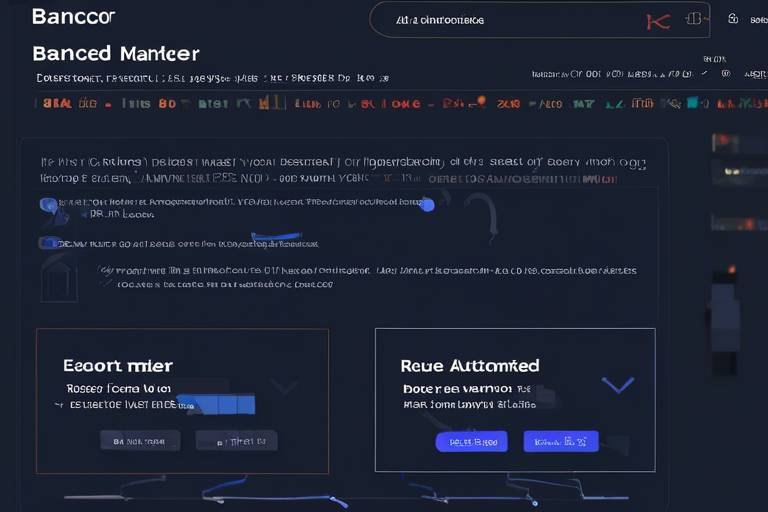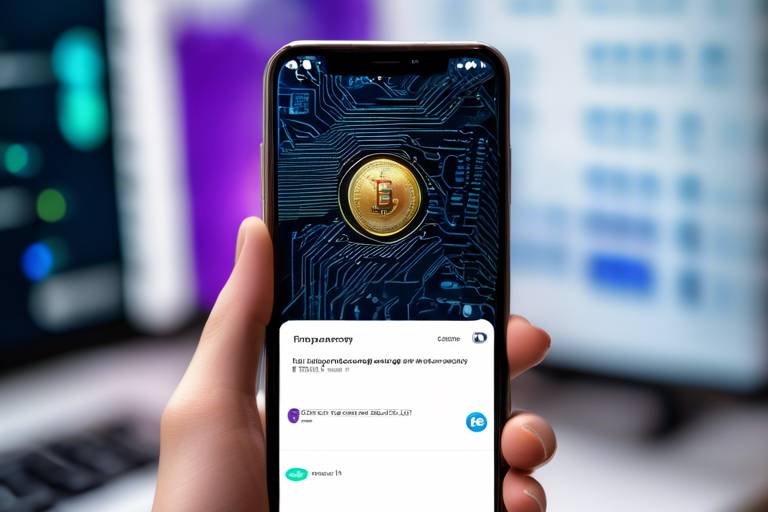Bancor - Automated Market Maker Explained
In the ever-evolving world of cryptocurrency, finding efficient ways to trade and exchange tokens can be a game-changer. Enter Bancor, a decentralized liquidity network that is taking the trading landscape by storm. Unlike traditional exchanges that rely on order books and market makers, Bancor utilizes a revolutionary technology known as automated market-making (AMM). This allows users to swap tokens directly and seamlessly without the need for intermediaries, making the trading experience not only faster but also more accessible to everyone.
Bancor's platform operates on the principles of decentralization, meaning that it is not controlled by any single entity. Instead, it leverages smart contracts to automate the trading process, ensuring that transactions are executed efficiently and securely. Imagine being able to trade your tokens at any time without worrying about market volatility or the availability of buyers and sellers. That's the beauty of Bancor, and it’s revolutionizing the way we think about trading in the cryptocurrency space.
But what exactly makes Bancor stand out? One of its most significant features is its liquidity pools. These pools are collections of tokens that users deposit into the Bancor network, providing the necessary liquidity for trading. This system not only enhances market stability but also allows users to earn rewards for their contributions. It’s like being part of a community where everyone benefits from the collective effort. So, whether you're a seasoned trader or a newcomer, Bancor offers a unique and efficient way to engage with the crypto market.
In summary, Bancor is not just another trading platform; it’s a comprehensive liquidity solution that empowers users to trade tokens directly and efficiently. With its innovative use of automated market-making technology, Bancor is setting new standards in the cryptocurrency trading landscape. In the following sections, we will dive deeper into how Bancor works, the mechanics of its liquidity pools, and the benefits it offers to users, as well as the risks that come with using this groundbreaking platform.
- What is Bancor? Bancor is a decentralized liquidity network that allows users to swap tokens directly without traditional exchanges.
- How does Bancor work? It uses automated market-making technology and smart contracts to facilitate trades efficiently.
- What are liquidity pools? Liquidity pools are funds provided by users that enable trading on the platform.
- What are the risks of using Bancor? Users should be aware of impermanent loss and smart contract vulnerabilities.
- How can I create a liquidity pool on Bancor? Users can create a liquidity pool by depositing tokens into the Bancor platform, following specific guidelines.

What is Bancor?
Bancor is a revolutionary decentralized liquidity network that transforms the way we think about trading in the cryptocurrency space. Imagine a world where you can swap tokens directly, without the cumbersome processes of traditional exchanges. That's precisely what Bancor offers! By leveraging the power of smart contracts, it automates the trading process, making it not only efficient but also incredibly accessible to users worldwide.
At its core, Bancor allows users to convert various tokens seamlessly. This means you can trade one cryptocurrency for another without the need for an intermediary, which is a game changer in the blockchain ecosystem. Instead of relying on centralized exchanges that often come with high fees and slow transaction times, Bancor provides a platform where trades can occur instantly and at a fraction of the cost.
One of the standout features of Bancor is its use of Automated Market Makers (AMMs). Unlike traditional order book exchanges that match buyers and sellers, AMMs use algorithms to determine the price of tokens based on supply and demand. This system ensures that there is always liquidity available for users, allowing for smoother and more reliable trading experiences.
Moreover, Bancor's decentralized nature means that it operates on a trustless basis. Users retain control of their funds and can participate in the liquidity pools without fear of losing their assets to hacks or mismanagement, which are common concerns in centralized systems. With Bancor, you can trade with confidence, knowing that your assets are secure and that you are part of a larger community of like-minded traders.
In summary, Bancor is not just another trading platform; it represents a paradigm shift in how we exchange value in the digital world. By utilizing advanced technology and fostering a decentralized environment, Bancor is paving the way for a more inclusive and efficient trading ecosystem.

How Automated Market Makers Work
Automated Market Makers (AMMs) like Bancor are the backbone of decentralized trading, revolutionizing how we swap tokens in the crypto realm. Unlike traditional exchanges that rely on order books and buyers/sellers making trades, AMMs utilize algorithms to price assets and facilitate trades automatically. This means that instead of waiting for someone to match your buy or sell order, you can instantly trade against a liquidity pool, which is essentially a pool of funds locked in smart contracts. Think of it as a digital vending machine: you put in a token, and out comes another token, all without the hassle of negotiating prices with other traders.
At the heart of this system is a pricing algorithm that determines how much of one token you get in exchange for another. The most common algorithm used by AMMs is the constant product formula, which maintains a constant product of the quantities of the two tokens in the pool. For example, if you have a pool of Token A and Token B, the equation would look something like this: x * y k, where x is the quantity of Token A, y is the quantity of Token B, and k is a constant. This means that as you increase the amount of Token A you want to swap, the amount of Token B you receive decreases, and vice versa. It’s a clever way to ensure that the market remains balanced and that there’s always enough liquidity for trades.
The beauty of AMMs lies in their accessibility. Anyone can provide liquidity by depositing tokens into these pools, and in return, they earn a share of the transaction fees generated by traders swapping tokens. This creates a win-win situation: traders get instant access to liquidity, while liquidity providers earn rewards for their contributions. The entire process is transparent and governed by smart contracts, which execute trades based on predefined rules without the need for intermediaries. This not only reduces costs but also minimizes the risk of manipulation that can occur in traditional markets.
However, it’s important to note that while AMMs simplify trading, they also introduce new dynamics. For instance, the price of tokens in a liquidity pool can diverge from the market price due to supply and demand fluctuations, leading to what is known as arbitrage opportunities. Traders can exploit these price differences across different platforms, which can further enhance market efficiency. But this also means that liquidity providers need to be aware of potential impermanent loss, which we’ll discuss in detail later.
In summary, Automated Market Makers like Bancor are game-changers in the world of cryptocurrency trading. By leveraging smart contracts and liquidity pools, they enable seamless token swaps and create opportunities for users to earn rewards. This innovative approach not only democratizes access to trading but also paves the way for a more efficient and liquid market.

Liquidity Pools Explained
Liquidity pools are the backbone of Automated Market Makers (AMMs) like Bancor. They act as a reservoir of funds that facilitates the trading of tokens without the need for traditional order books. Imagine a swimming pool filled with various tokens; traders can jump in and make swaps without waiting for someone to sell or buy at a specific price. This model eliminates the need for a counterparty, making trading much more efficient and accessible.
Each liquidity pool consists of two or more tokens that are locked in a smart contract. When users want to swap one token for another, they draw from this pool. The smart contract automatically calculates the price based on the ratio of the tokens in the pool. This mechanism is not only efficient but also ensures that prices are adjusted in real-time, reflecting the supply and demand dynamics of the market.
One of the most appealing aspects of liquidity pools is their ability to provide liquidity for various trading pairs. This means that even lesser-known tokens can be traded, as long as there is a liquidity pool available. The more liquidity a pool has, the easier it is to execute large trades without causing significant price slippage. Slippage refers to the difference between the expected price of a trade and the actual price. In a well-funded liquidity pool, slippage is minimized, allowing traders to get better prices for their transactions.
To create a liquidity pool, users can deposit equal values of two tokens into Bancor's platform. For example, if a user wants to create a liquidity pool for Token A and Token B, they must deposit an equal dollar amount of both tokens. This ensures that the pool remains balanced, which is crucial for maintaining price stability. Once the pool is created, it becomes accessible to other traders, and the original depositor earns a share of the transaction fees generated from trades made within that pool.
In summary, liquidity pools are essential for the operation of AMMs. They provide the necessary funds for trading, enable real-time price adjustments, and allow for the trading of a wide variety of tokens. As we delve deeper into the world of decentralized finance (DeFi), understanding liquidity pools becomes increasingly important for anyone looking to navigate this exciting new landscape.
- What are liquidity pools? Liquidity pools are collections of funds locked in smart contracts that facilitate trading without the need for a traditional order book.
- How do liquidity pools work? They use algorithms to price assets and allow users to swap tokens directly, with prices adjusted based on the supply and demand of the tokens in the pool.
- Can anyone create a liquidity pool? Yes, users can create liquidity pools by depositing equal values of two tokens into Bancor's platform.
- What are the benefits of providing liquidity? Liquidity providers earn transaction fees and may also receive additional rewards in the form of tokens.

Creating Liquidity Pools
Creating liquidity pools on Bancor is a straightforward process that empowers users to contribute to the decentralized finance (DeFi) ecosystem. To get started, you need to have a compatible cryptocurrency wallet and some tokens ready to deposit. The beauty of Bancor lies in its user-friendly interface, which guides you through the steps seamlessly. First, you will need to connect your wallet to the Bancor platform. This connection is crucial as it allows you to interact with the smart contracts that govern the liquidity pools.
Once your wallet is connected, you can choose the tokens you wish to deposit. It's important to note that you can provide liquidity for various token pairs. For instance, if you have Ethereum (ETH) and a stablecoin like USDC, you can create a liquidity pool for that pair. The process typically involves the following steps:
- Select the Token Pair: Choose the two tokens you want to provide liquidity for.
- Deposit Tokens: Specify the amount of each token you wish to deposit into the pool.
- Confirm Transaction: Review the transaction details and confirm your deposit.
After confirming the transaction, the smart contract will automatically create a liquidity pool for the selected token pair. Your deposited tokens will be locked in the pool, and in return, you will receive liquidity pool tokens that represent your share in the pool. These tokens are essential as they allow you to withdraw your share of the pool along with any accrued fees.
Creating liquidity pools not only enhances your potential for earning rewards but also contributes to the overall liquidity of the market, making it more efficient for other users. By participating in this way, you play a vital role in the ecosystem, helping to ensure that traders can swap tokens quickly and with minimal slippage.
Furthermore, it's worth mentioning that Bancor allows you to create liquidity pools with a single token due to its unique implementation of the continuous liquidity model. This means that you can provide liquidity without having to pair two different tokens, which is a significant advantage for users who may only hold one type of asset.
In conclusion, creating liquidity pools on Bancor is not just about depositing tokens; it's about engaging in a decentralized financial system that rewards users for their participation. As you contribute to liquidity, you also gain the opportunity to earn fees generated from trades within the pool, making it a win-win situation for everyone involved.
Q1: What are liquidity pools?
A liquidity pool is a collection of funds locked in a smart contract that facilitates trading by providing liquidity for users looking to swap tokens.
Q2: Can I create a liquidity pool with just one token?
Yes, Bancor allows users to create liquidity pools with a single token, thanks to its innovative continuous liquidity model.
Q3: How do I earn rewards as a liquidity provider?
Liquidity providers earn rewards through transaction fees generated from trades within the pool, which are distributed proportionally based on the amount of liquidity they provide.
Q4: What are the risks involved in providing liquidity?
While providing liquidity can be profitable, risks include impermanent loss and potential vulnerabilities associated with smart contracts.

Incentives for Liquidity Providers
When it comes to decentralized finance (DeFi), liquidity providers are the backbone of platforms like Bancor. They play a crucial role in ensuring that trades can happen smoothly and efficiently. But what’s in it for them? Well, Bancor offers a variety of incentives that make it an attractive option for anyone looking to contribute liquidity to the network.
First and foremost, liquidity providers earn trading fees from every transaction that occurs within their liquidity pool. This means that for every trade made using the tokens they've deposited, they receive a small percentage of the transaction fee. Think of it as a reward for keeping the market flowing. The more trades that happen, the more fees they earn, creating a passive income stream that can be quite lucrative.
In addition to trading fees, Bancor has a unique feature known as BNT rewards. BNT, or Bancor Network Token, is the native token of the Bancor network. Liquidity providers can earn BNT tokens as additional rewards, which can be staked or traded. This dual reward system not only incentivizes users to provide liquidity but also encourages them to hold onto their BNT tokens, further stabilizing the network.
Moreover, Bancor employs a mechanism called impermanent loss protection. This is a game-changer for liquidity providers, as it mitigates the risks associated with price fluctuations of the tokens in the liquidity pool. With this feature, if the value of their tokens decreases, Bancor compensates them with BNT rewards, effectively reducing the impact of impermanent loss. This safety net makes it less daunting for new users to enter the world of liquidity providing.
To summarize, the incentives for liquidity providers on Bancor include:
- Trading Fees: Earn a percentage from every trade made in the pool.
- BNT Rewards: Additional income through native token rewards.
- Impermanent Loss Protection: Mitigates the risks associated with price fluctuations.
In essence, Bancor not only rewards liquidity providers for their contributions but also prioritizes their security and profitability. This creates an ecosystem where users can feel confident in their investments while actively participating in the growth of the DeFi space.
Q: How do I become a liquidity provider on Bancor?
A: To become a liquidity provider, you need to deposit tokens into a liquidity pool on the Bancor platform. Simply connect your wallet, select the tokens you want to provide, and follow the prompts to add liquidity.
Q: What happens if I withdraw my tokens from a liquidity pool?
A: When you withdraw your tokens, you will receive your initial investment back along with any earned trading fees and BNT rewards, subject to the current value of the assets in the pool.
Q: Is there a minimum amount required to provide liquidity?
A: While there is no strict minimum, it is generally advisable to contribute a reasonable amount to make the most out of the trading fees and rewards.
Q: Can I lose money by providing liquidity?
A: Yes, there is a risk of impermanent loss due to price fluctuations. However, Bancor's impermanent loss protection helps mitigate this risk.

Benefits of Using Bancor
Bancor is not just another name in the crowded crypto space; it offers a multitude of benefits that set it apart from traditional trading platforms. One of the most significant advantages is the reduced slippage during trades. In traditional exchanges, slippage can occur when large orders impact the market price. Bancor’s automated market maker (AMM) model mitigates this by providing liquidity directly from pools, ensuring that users can execute trades at prices closer to their expectations.
Another compelling feature of Bancor is its lower transaction fees. Unlike conventional exchanges that charge hefty fees for trades, Bancor operates on a decentralized model that significantly reduces costs. This is particularly beneficial for traders who frequently engage in small transactions, as the savings can accumulate over time. Additionally, the absence of order book mechanics means that users can swap tokens directly without the delays and fees associated with matching buy and sell orders.
Accessibility is yet another hallmark of Bancor. By utilizing smart contracts, it allows users to trade tokens directly from their wallets without needing to deposit funds into a centralized exchange. This not only enhances security but also empowers users with greater control over their assets. Imagine being able to trade your digital assets as easily as sending an email; that’s the level of accessibility Bancor aims to provide!
Furthermore, Bancor offers a unique feature known as liquidity mining. This allows users to earn rewards by providing liquidity to the pools. It’s akin to earning interest on your savings account, but in the cryptocurrency realm. Users can deposit their tokens into a liquidity pool and receive rewards in the form of additional tokens. This not only incentivizes users to contribute to the ecosystem but also helps maintain the liquidity necessary for efficient trading.
Lastly, Bancor’s innovative approach to impermanent loss protection is a game-changer. Traditional AMMs often expose liquidity providers to the risk of losing value due to price fluctuations. However, Bancor implements mechanisms that help mitigate this risk, making it a safer option for those looking to engage in liquidity provision. This feature alone can make a substantial difference for users who are wary of the volatility inherent in the crypto markets.
In summary, the benefits of using Bancor are multifaceted, ranging from reduced slippage and lower fees to enhanced accessibility and innovative liquidity mining options. For anyone navigating the complex waters of cryptocurrency trading, Bancor stands out as a beacon of efficiency and opportunity.
- What is Bancor? Bancor is a decentralized liquidity network that allows users to swap tokens directly without relying on traditional exchanges.
- How does Bancor reduce slippage? By utilizing liquidity pools instead of order books, Bancor minimizes the impact of large trades on market prices.
- What is liquidity mining? Liquidity mining is a process where users provide liquidity to pools and earn rewards in the form of additional tokens.
- What are the risks associated with Bancor? Users should be aware of impermanent loss and potential smart contract vulnerabilities when using the platform.

Risks Associated with Bancor
While Bancor offers an innovative approach to decentralized trading, it’s crucial to understand that it comes with its own set of risks. Just like any other investment opportunity, the allure of automated market-making can be clouded by potential pitfalls that users should be aware of. One of the most significant risks is impermanent loss, which occurs when the value of tokens in a liquidity pool fluctuates. This can happen due to market volatility, and it can lead to liquidity providers losing out on potential profits compared to simply holding their tokens. Imagine putting your money into a pool only to find that the water level has dropped significantly; that’s essentially what impermanent loss feels like.
Additionally, there are smart contract risks to consider. Smart contracts are the backbone of Bancor's functionality, automating trades and managing liquidity pools. However, if there are vulnerabilities in the code, they can be exploited by malicious actors, leading to significant financial losses. It’s like having a secure vault that, unbeknownst to you, has a hidden flaw that a thief can exploit. The importance of robust security audits cannot be overstated, as they help identify and mitigate these risks before they become a problem.
Another aspect to consider is the market risk associated with the volatility of cryptocurrency prices. The crypto market is notoriously unpredictable, and while Bancor aims to provide liquidity, the inherent fluctuations can impact the overall trading experience. Users should be prepared for the possibility that their investments can decrease in value, sometimes dramatically, in a short period. It's vital to approach trading on Bancor with a clear understanding of your risk tolerance and investment strategy.
To summarize, here are the key risks associated with using Bancor:
- Impermanent Loss: Losses incurred when the value of tokens in a pool fluctuates.
- Smart Contract Vulnerabilities: Potential risks arising from flaws in smart contract code.
- Market Volatility: The unpredictable nature of cryptocurrency prices can affect trading outcomes.
By being aware of these risks, users can make more informed decisions when participating in the Bancor network. Remember, every investment carries risk, and understanding those risks is the first step in mitigating them. So, before diving into the world of decentralized trading, take a moment to assess your strategy and ensure you’re equipped to handle the potential challenges that may arise.
What is impermanent loss?
Impermanent loss refers to the temporary loss of funds that occurs when the value of tokens in a liquidity pool changes compared to when they were deposited. It’s a risk that liquidity providers face in automated market makers like Bancor.
How can I mitigate impermanent loss?
While impermanent loss cannot be entirely avoided, strategies such as diversifying your assets and choosing stable pairs can help reduce the impact. Additionally, staying informed about market trends can aid in making timely decisions.
Are smart contracts safe on Bancor?
Bancor employs rigorous security audits to minimize the risks associated with smart contracts. However, as with any technology, there is always a risk of vulnerabilities. It’s essential for users to stay updated on security practices and potential risks.
Can I lose all my investment on Bancor?
While it’s unlikely to lose your entire investment, significant losses can occur due to market volatility, impermanent loss, or smart contract vulnerabilities. It’s crucial to invest only what you can afford to lose and to conduct thorough research before participating.

Impermanent Loss Explained
Impermanent loss is a term that every liquidity provider in the world of decentralized finance (DeFi) should be familiar with. Imagine you’ve decided to put your hard-earned tokens into a liquidity pool on Bancor, hoping to earn some rewards. However, as the market fluctuates, the value of the tokens you deposited might change. This phenomenon is known as impermanent loss, and it can significantly affect your overall returns.
To put it simply, impermanent loss occurs when the price of the tokens you have in a liquidity pool diverges from the price at which you deposited them. The greater the price divergence, the more you stand to lose. Let’s visualize this with a simple analogy: think of it like a seesaw. When both sides are balanced (the prices of your tokens remain stable), you’re in a good position. But if one side starts to rise while the other drops, it creates an imbalance, leading to potential losses.
Here’s how impermanent loss works in practice: when you provide liquidity to a pool, you typically deposit two tokens. The automated market maker (AMM) then uses a formula to maintain a balance between these tokens. If the price of one token rises significantly compared to the other, the AMM will automatically adjust the ratio of tokens in the pool to maintain balance. This means you might end up with less of the appreciating token and more of the depreciating one when you withdraw your liquidity.
To give you a clearer picture, let’s consider a hypothetical example:
| Scenario | Initial Value | Final Value | Impermanent Loss |
|---|---|---|---|
| Token A | $100 | $150 | -$20 |
| Token B | $100 | $80 |
In this scenario, you initially deposited tokens worth $200. After some time, Token A appreciated while Token B depreciated, resulting in an impermanent loss of $20 when you decide to withdraw your tokens. If you had simply held onto the tokens instead of providing liquidity, you would have had a different outcome.
While impermanent loss can be daunting, there are strategies you can employ to mitigate its impact. For instance, choosing liquidity pools with stablecoin pairs can help reduce volatility. Additionally, you might consider diversifying your investments across multiple pools to spread the risk. Remember, the goal is to strike a balance between earning rewards and managing potential losses.
Ultimately, understanding impermanent loss is crucial for anyone looking to dive into the world of liquidity provision. It’s a bit like riding a roller coaster; there are ups and downs, but with the right knowledge and strategies, you can enjoy the ride while minimizing the risks.
- What is impermanent loss? Impermanent loss refers to the potential loss in value of tokens in a liquidity pool due to price fluctuations compared to holding the tokens outright.
- How can I minimize impermanent loss? You can minimize impermanent loss by providing liquidity to stablecoin pairs, diversifying your investments, and keeping an eye on market trends.
- Is impermanent loss permanent? No, it is called "impermanent" because if the prices of the tokens return to the original deposit price, the loss can be mitigated.

Smart Contract Risks
When diving into the world of Bancor, it's essential to understand that smart contracts are the backbone of this decentralized liquidity network. These contracts automatically execute trades and manage liquidity pools without human intervention. However, like any technology, they are not without their risks. One of the most significant concerns is the potential for vulnerabilities within the smart contracts themselves. If a bug or flaw exists in the code, it could be exploited, leading to significant financial losses for users.
Moreover, the complexity of smart contracts can sometimes lead to unforeseen issues. Even well-audited contracts can have hidden flaws that only emerge under specific conditions. This is where the importance of security audits comes into play. Regular audits by reputable firms can help identify vulnerabilities before they can be exploited, but they are not foolproof. Users must remain vigilant and understand that even the most secure smart contracts carry some level of risk.
Another aspect to consider is the immutability of blockchain technology. Once a smart contract is deployed, it cannot be altered. This means that if a vulnerability is discovered after deployment, there may be no way to fix it without creating a new contract and migrating users' funds. This situation can lead to panic among users, potentially causing a mass withdrawal from liquidity pools, which can destabilize the market.
In addition to these technical risks, there are also human factors to consider. Users may inadvertently interact with malicious contracts or fall victim to phishing attacks aimed at compromising their wallets. Education and awareness are crucial in mitigating these risks. Users should take the time to research and understand the contracts they are engaging with, ensuring they are interacting with legitimate platforms.
In summary, while smart contracts are a revolutionary aspect of platforms like Bancor, they come with inherent risks that users must navigate. Being aware of these risks, conducting thorough research, and employing best practices can help users protect their investments in the ever-evolving cryptocurrency landscape.
- What is a smart contract? A smart contract is a self-executing contract with the terms of the agreement directly written into code. They run on blockchain technology and automate processes without the need for intermediaries.
- How can I ensure the safety of my funds when using Bancor? Always conduct thorough research on the smart contracts you interact with, use reputable platforms, and consider using hardware wallets for added security.
- What should I do if I suspect a vulnerability in a smart contract? If you suspect a vulnerability, it is crucial to withdraw your funds immediately and report the issue to the platform's support team.
Frequently Asked Questions
- What is Bancor?
Bancor is a decentralized liquidity network that enables users to swap various tokens directly, bypassing traditional exchanges. It uses smart contracts to automate the trading process, making it more efficient and accessible for everyone.
- How do Automated Market Makers (AMMs) work?
AMMs like Bancor utilize algorithms to set asset prices and facilitate trades. Unlike traditional order book exchanges that match buyers and sellers, AMMs rely on liquidity pools to provide the necessary funds for trading, ensuring a seamless experience for users.
- What are liquidity pools?
Liquidity pools are collections of tokens locked in a smart contract that provide liquidity for trading on platforms like Bancor. These pools are essential for maintaining market stability and ensuring that users can swap tokens without significant delays or slippage.
- How can I create a liquidity pool on Bancor?
Creating a liquidity pool on Bancor is straightforward. Users need to deposit tokens into the platform, and once the deposit is made, they can set parameters for the pool. This process not only helps enhance market liquidity but also offers potential rewards for the liquidity provider.
- What incentives does Bancor offer to liquidity providers?
Bancor rewards liquidity providers with a portion of the trading fees generated by the pool. These rewards are calculated based on the amount of liquidity contributed and the overall performance of the pool, making it a lucrative opportunity for users.
- What are the benefits of using Bancor over traditional exchanges?
Bancor offers several advantages, including reduced slippage, lower transaction fees, and greater accessibility for users. This makes it an attractive option for traders looking to maximize their trading efficiency while minimizing costs.
- What risks should I be aware of when using Bancor?
While Bancor provides many benefits, users should be aware of potential risks such as impermanent loss and smart contract vulnerabilities. It's crucial to understand these risks to make informed decisions when participating in liquidity pools.
- What is impermanent loss?
Impermanent loss occurs when the value of tokens in a liquidity pool fluctuates, potentially leading to a lower overall value compared to simply holding the tokens. Understanding this concept is vital for liquidity providers to manage their investments effectively.
- How can I mitigate the effects of impermanent loss?
Strategies to mitigate impermanent loss include choosing stable pairs for liquidity provision, monitoring market conditions, and diversifying your investments across multiple pools. Being proactive can help reduce the impact of market volatility.
- What are the smart contract risks associated with Bancor?
Smart contracts are central to Bancor's operations, but they can be vulnerable to bugs or exploits. It's essential to ensure that the smart contracts are regularly audited to protect user funds and maintain the integrity of the platform.



















